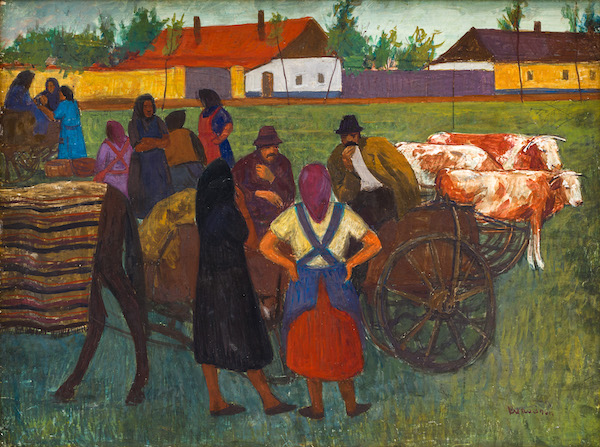Biography
István D. Kurucz was born in Hódmezővásárhely in 1914. He applied to the School of Applied Arts in Budapest, from there he entered to the private school of Szőnyi in 1933. He enrolled at the College of Fine Arts the following year, where he graduated in 1941. In 1935-36, at the suggestion of Miklós Galyasi, secretary of the Tornyai Society, his hometown voted him a scholarship. He attended the classes of István Réti, Ágost Benkhardt and Gyula Rudnay, but perhaps the greatest influence on him was István Szőnyi and Sándor Nagy, from whom he learned the fresco technique.
In 1942, he studied in Rome on a scholarship. Here he exhibits his first works. After returning home, in 1943, he presented his Italian paintings in Hódmezővásárhely. His first exhibition in Budapest was held in 1947 in the Műcsarnok. Then Kurucz D. moved to the capital and became the leader of the visual artist circle of the Kossuth Academy.
Between 1949-1959, he taught fresco technique at the college as a teaching assistant. Between 1951 and 1952, he organized the Honvédség Fine Arts Studio, and was then appointed director of the Honvéd Fine Arts School. In 1953, the Fine Arts Fund opened an artist colony in his house and studio in Vásárhely.He played a significant role in starting the Vásárhely Autumn Exhibitions. He went on many study trips, visiting Japan, Mongolia, and Algeria, among others. In 1962, he exhibited the XXXI. at the Venice Biennale. In 1964, he created murals depicting the battles of the Hungarian Soviet Republic for the Party House in Pápa. He organized and led the Mednyánszky Society, and until his death was the president of the Hajdúság International Artists' Colony and the Hortobágy Art Camp.
István D. Kurucz's art is a continuation of the so-called alföldi painting. When he was young, he attended the meetings of the Socialist Artists Group, he wanted to create a monumental, community art. His master teachers (Szőnyi, Nagy) and his scholarship years in Italy certainly played a role in the rediscovery of fresco and tempera painting. The influence of Gyula Derkovits can be felt in the works of his first period, in the 1940s, in which he always depict everyday life in the countryside. It is characterized by two main types of the relationship between the landscape and man: one elevates the figures to a monumental level, who almost fill the space by creating irregular image cutouts, which testify to the knowledge of contemporary sociophotos (e.g. Disznóvásár, 1939; Tyúketetés, 1943). In the other type, the landscape takes on a more prominent role, and its entirety is counterpointed with small, backlit figures.
In his pictures, he uses the gesso paint process: he places a plaster base on the plate, and apply the oil tempera on it unmixed. Finally, the finished painting is ironed with warm wax, which enhances and preserves the paint.
After the Second World War, his compositional methods became simpler, but in his pictures the realities of the peasant way of life no longer appear as symbols of social immobility, but of purposeful and useful human life and moral values (Fisherman, 1945, Land Distribution, 1946). In his other works, he depicts the civilization and modernization of field work, creating a new type of "socialized" landscape and with it the collectivized picture of the Alföld ('Great Plains') (Trashing, 1958; Harvesting, 1960). The problems of the lowlands are also connected to the increasing number of landscape depictions in the 60s, the main theme of which is the all-embracing infinity of the lowland landscape with a deep horizon, mostly devoid of people (White Farms, Winter, 1963).
In his late period, his landscapes show the deeper structures of nature. Several of his panel and fresco designs, such as the Battle of Mohács and the story of the Hajdúság, remained in drafts or were only partially executed. He was also concerned with theoretical questions, and wrote several articles and studies on the issues of art teaching, artist training, art trade and art policy.

